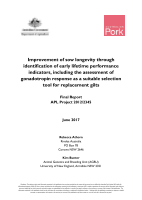Library & Resources
Library & Resources
Complete Research Reports
Item Details

Improvement of sow longevity through identification of early lifetime performance indicators, including the assessment of gonadotrophin response as a suitable selection tool for replacement gilts
41 Pages
Author(s): Dr Rebecca Athorn
High sow turn over or replacement rate is an ongoing issue in the Australian pig industry. High sow turnover within a herd leads to a reduction in sow lifetime performance (calculated as the number of pigs produced per female per day of herd life), especially if replacement rates for early parity sows are high. High sow turnover rates result in a higher proportion of younger sows in the herd, in particular gilts, leading to increases in HFC (feed consumed per unit carcass weight produced) due to a greater proportion of gilt progeny within the herd (Smits, 2011). Over the past decade there has been considerable research into this topic, however, little improvement has been made. Focussing on the development of the replacement gilt from birth up until the time of selection, with particular focus on early-in-life parameters such as pre-weaning growth and development, rather than just weight for age and conformation at the time of selection into the breeding herd could be one way to improve the selection process in order to select replacement gilts with improved longevity and lifetime performance. Therefore, by focussing on the development of the replacement gilt from birth up until the time of selection, with particular focus on pre-weaning growth and development, it is hypothesised that risk factors associated with poor sow longevity can be identified and interventions sought that can help reduce the effects of these factors.
Download



